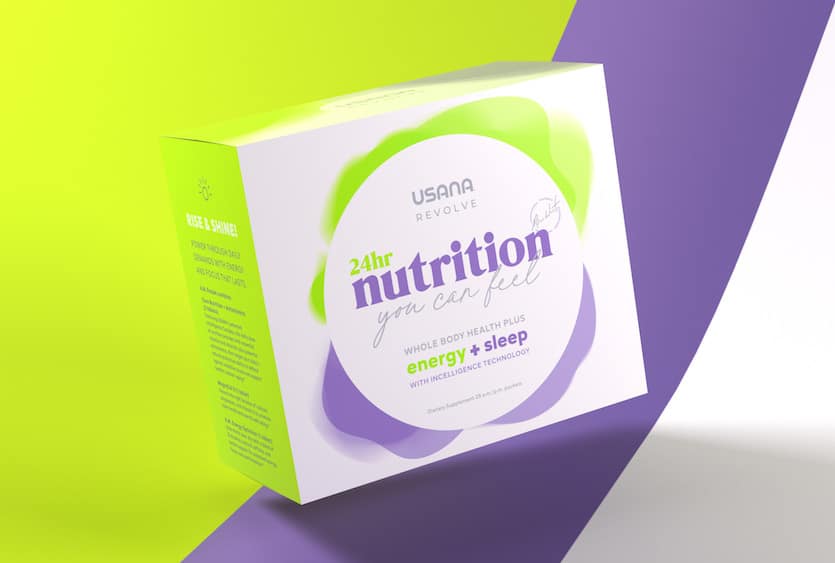USANA 24 小时能量+睡眠套装
USANA 24 小时能量+睡眠套装在您忙碌之际为您提供必要营养素。和USANA 细胞基本营养素一样提供全面性的维生素、矿物质、抗氧成分和营养支持您拥有长期健康。*
好处还不仅如此。两款独特的小包 (早晨小包与早餐一起服用,晚间小包于睡前服用),配合您的身体自然昼夜节律而设计。您将整天活力满满,夜晚时一觉好眠。*
这两小包含有:
- 必需的维生素和矿物质
- USANA 独特的 InCelligence 複合物有助于延长寿命
- 含有一早唤醒您和提供持久能量的成分
- 夜晚助您睡前放松
使用早晨小包让您精神饱满
USANA 24 小时能量+睡眠套装的早晨小包为您提供充足的营养,让您整天充满能量——内含 2 锭核心营养锭、1片USANA 活力钙镁 D 片和 1 锭能量优化剂(有关更多能量优化剂内容请参考以下)。
您的身体无法自行产生所需的维生素和矿物质。均衡饮食是各种身体过程正常运作的必要条件,包括:
- 细胞生长和修復
- 产生能量
- 免疫功能
- 骨骼健康
- 神经系统功能
- 新陈代谢
水果、蔬菜和全穀物的健康饮食可以提供平衡的维生素和必需矿物质。然而,如果您的饮食习惯不够完美,您可能无法摄取足够的多种营养。如果您有任何饮食限制,这将增加困难度。
USANA 核心营养和活力钙镁 D 片有助于填补维生素和矿物质的营养缺口,让您全身健康。此外,它还包含 USANA 的 InCelligence 複合物,可支持细胞的健康和长寿。*
这种独特的複合物由强效成分配方组成,支持细胞讯号传输通路,帮助您的细胞做出反应并适应生活中遇到的任何问题。*
InCelligence 複合物支持的两条最重要的细胞途径是:
- 在细胞中产生内源性抗氧化成分,提供强大的抗氧化保护
- 激活线粒体自噬,一种细胞清理过程,有助于更新有效的能量生产,为细胞提供动力*
炫能能量优化剂主动维持身体能量
除了必要的营养外,24 小时能量+睡眠套装的早晨小包含有一锭能量优化锭,它能强化您的早晨日常活动并帮助您感觉量好。
天然咖啡因可以帮助您保持警觉、集中注意力并提高能量水平。这种常见的兴奋剂主要存在于咖啡、茶、可乐和能量饮料中。咖啡因能够阻断腺苷(让您感到放松且疲倦的神经递质)。咖啡因能阻断腺苷,您的大脑和神经系统会感觉能量充足。
早晨能量优化锭含 40 毫克咖啡因,大约半杯咖啡。这是为什麽 USANA 炫能让您整天身心充满活力的方式。
早晨小包提供细胞所需的 B 族维生素,将您吃的食物转化为能量,有助于新陈代谢和产生能量。如果没有足够的 B 族维生素,您就无法有效地进行生化过程来产生能量。摄入高剂量的 B 族维生素并不能为您提供无限的体能,但如果摄入不足,您可能会感到疲倦。
人参是一种植物根属于人参属。历史上,它为传统中医(TCM)的能量补品。如今,它因为帮助身体应对身心压力以及提高注意力和其它心理功能的能力而闻名。人参也是一种强抗氧化剂,可能对多种身体系统都有好处。
USANA 24 小时能量+睡眠套装里的能量优化锭由这些关键成分配製而成,可提供持久的能量。您每天早上都可以感到您营养足够。*
使用晚间小包身心放松准备睡觉
USANA 24 小时能量+睡眠套装的晚间小包含 1 锭活力钙镁 D 片和 1 锭睡眠优化剂,为您提供营养和化合物,促进睡眠和安定。结合起来,它们以几种不同的方式发挥作用。
USANA 24 小时能量+睡眠套装含有独家睡眠优化剂,它含有 GABA(γ-氨基丁酸),它是一种神经递质,可通过关闭清醒功能和安定神经活动来帮助平静大脑和身体。
晚间小包含有L—茶氨酸,一种已被证明可以增加 GABA 的水平的氨基酸,有助于促进大脑的放松状态。
褪黑激素是一种神经递质,在您的体内产生,有助于调节您的睡眠清醒週期。睡眠清醒週期有时会被压力、夜晚工作、旅行、晚间饮酒或咖啡因等因素打乱。退黑激素补充品可模彷体内自然产生的褪黑激素并产生同样的效果。睡前服用 USANA 24 小时能量+睡眠套装的晚间小包有助于提高褪黑激素,帮助减少专注力、感到困倦,并最终入睡。
镁不仅仅有益于骨骼健康。它对于帮助放松肌肉和大脑也很重要。这种重要的营养素需要物理存在才能使肌肉在收缩后放松。它还会增加两种输入神经递质 GABA 和褪黑激素(如上所述)的水平。
印度人参是一种适应原草本植物,已被证明可以减轻压力和焦虑。它可以帮助身体适应压力和减少皮质醇(一种压力荷尔蒙会干扰睡眠)的产生来促进睡眠。
睡前服用晚间小包可放松肌肉、减少焦虑并促进安宁的睡眠。*
以下是一些促进睡眠和平心静气的方法:
- 建立睡前放松仪式
- 房间保持黑暗、宁静和凉爽
- 睡前避免摄入咖啡因和酒精
- 规律运动,但别在睡前运动
产品内容
早晨小包
- 核心营养(2锭)
- 活力钙镁 D 片(1 锭)
- 能量优化剂 (1 锭)
晚间小包
- 活力钙镁 D 片(1 锭)
- 睡眠优化剂(1 锭)
使用方法
早上服用 (1) 包早晨小包,建议随餐服用。睡前服用 (1) 包晚间小包。晚上 7:00 后请勿服用早晨小包。服用晚间小包后,请勿驾驶或操作机器,因内含褪黑激素。
Revolve 24 小时能量+睡眠套装常见问题
USANA Revolve 24 小时能量+睡眠套装与 USANA 细胞基本营养素能同时使用吗?
不能。Revolve 24 小时能量+睡眠套装是细胞基本营养素或健康套装的替代品,不得与这些产品同时服用。同时使用这些产品可能导致某些营养素超出既定上限摄取量(UL)。
Revolve 24 小时能量+睡眠套装营养成分与细胞基本营养素有什么不同之处?
Revolve 24 小时能量+睡眠套装和细胞基本营养素皆含有多种维生素和必要矿物质。这两项产品最大的差别在于其它有益成分的含量。
Revolve 24 小时能量+睡眠套装的其它成分(如咖啡因、韩国人参、南非醉茄、褪黑激素和 GABA)着重于帮助支持您的自然昼夜节律。相比 Revolve 24 小时能量+睡眠套装,细胞基本营养素含有双倍剂量的专利认证 USANA InCelligence 复合物、额外的抗氧化成分和微量矿物质。
每日剂量完整比较
| 营养成分 | Revolve 24 小时能量+睡眠套装 |
细胞基本营养素 | 健康套装 |
| 维生素A | 2700 微克 RAE | 3608 微克 RAE | 3608 微克 RAE |
| 维生素 C | 324 毫克 | 1000 毫克 | 1000 毫克 |
| 维生素 D3 | 31 微克 | 50 微克 | 62 微克 |
| 维生素 E | 82 毫克 | 134 毫克 | 134 毫克 |
| 维生素 K | 60 微克 | 480 微克 | 480 微克 |
| 维生素 K2 | 60 微克 | 60 微克 | |
| 硫胺素 | 55 毫克 | 30 毫克 | 30 毫克 |
| 核黄素 | 45 毫克 | 30 毫克 | 30 毫克 |
| 烟酸 | 36 毫克 NE | 40 毫克 NE | 40 毫克 NE |
| 维生素 B6 | 74 毫克 | 32 毫克 | 32 毫克 |
| 叶酸 | 1271 微克 DFE | 1000 微克 DFE | 1000 微克 DFE |
| 维生素 B12 | 300 微克 | 200 微克 | 200 微克 |
| 生物素 | 560 微克 | 300 微克 | 300 微克 |
| 泛酸 | 55 毫克 | 90 毫克 | 90 毫克 |
| 胆碱 | 18 毫克 | 102 毫克 | 102 毫克 |
| 钙 | 288 毫克 | 226 毫克 | 476 毫克 |
| 铁 | 4.4 毫克 | ||
| 碘 | 150 微克 | 500 微克 | 500 微克 |
| 镁 | 288 毫克 | 226 毫克 | 476 毫克 |
| 锌 | 12 毫克 | 20 毫克 | 20 毫克 |
| 硒 | 150 微克 | 200 微克 | 200 微克 |
| 铜 | 0.99 毫克 | 2 毫克 | 2 毫克 |
| 锰 | 3 毫克 | 2 毫克 | 2 毫克 |
| 铬 | 50 微克 | 300 微克 | 300 微克 |
| 钼 | 50 微克 | 50 微克 | 50 微克 |
| 肌醇 | 30 毫克 | 128 毫克 | 128 毫克 |
| 硼 | 0.66 毫克 | 3 毫克 | 3.66 毫克 |
| α-硫辛酸 | 50 毫克 | 100 毫克 | 250 毫克 |
| Meriva 生物可利用姜黄素 | 36 毫克 | 72 毫克 | 72 毫克 |
| 绿茶提取物 | 35 毫克 | 70 毫克 | 70 毫克 |
| 二水槲皮素 | 30 毫克 | 60 毫克 | 180 毫克 |
| 芦丁 | 20 毫克 | 40 毫克 | 40 毫克 |
| 橙皮苷 | 20 毫克 | 40 毫克 | 40 毫克 |
| 白藜芦醇 | 20 毫克 | 40 毫克 | 40 毫克 |
| Olivol | 15 毫克 | 30 毫克 | 50 毫克 |
| 咖啡因(绿茶) | 40 毫克 | ||
| 高丽蔘 | 50 毫克 | ||
| L-茶氨酸 | 50 毫克 | ||
| 印度人参提取物 | 300 毫克 | ||
| 褪黑激素 | 2 毫克 | ||
| GABA | 125 毫克 | ||
| 矽 | 4 毫克 | 8.5 毫克 | |
| 钒 | 40 微克 | 40 微克 | |
| 超微量矿物质 | 3 毫克 | 3 毫克 | |
| L-胱氨酸 | 160 毫克 | 160 毫克 | |
| 混合生育酚 | 80 毫克 | 80 毫克 | |
| 辅酶 Q10 | 12 毫克 | 12 毫克 | |
| 叶黄素 | 600 微克 | 600 微克 | |
| 番茄红素 | 1000 微克 | 1000 微克 | |
| 紫檀 | 100 毫克 |
眠宁素可以与炫能晚间小包同时使用吗?
每包眠宁素和炫能晚间小包均含有 2 毫克褪黑激素。以长远来看,服用对您有效的最低剂量褪黑激素效果最佳。
如有需要,一锭眠宁素可与炫能晚间小包同时使用。当您同时使用眠宁素与炫能晚间小包,您将摄取 4 毫克黑激素。
如果我需要在夜间工作,我该何时使用炫能早晨和晚间小包?
您应该在睡觉前使用炫能晚间小包。对于轮班人士,清晨才是他们的睡觉时间。您可以在起床、准备展开新的一天时使用炫能早晨小包。
怀孕或哺乳的妇女可以使用Revolve 24 小时能量+睡眠套装吗?
不能。Revolve 24 小时能量+睡眠套装不适用怀孕或哺乳的妇女。作为替代,您可以考虑使用 USANA 产前细胞基本营养素。
青少年或儿童可以使用 Revolve 24 小时能量+睡眠套装吗?
不能。Revolve 24 小时能量+睡眠套装专为成人的营养需求打造。
参考文献
Ma Q. 2013. Role of Nrf2 in Oxidative Stress and Toxicity. Annu Rev Pharmacol Toxicol 53: 401-426.
Laplante M, Sabatini D. 2009. mTOR signaling at a glance. Journal of Cell Science 122: 3589-3594.
Han KS, Kim L, Shim I. 2012. Stress and sleep disorder. Exp Neurobiol 21(4): 141-150.
Czeisler CA. 2013. Perspective: casting light on sleep deficiency. Nature 497(7450): S13.
Xie Z, et al. 2017. A review of sleep disorders and melatonin. Neurol Res 39(6): 559-565.
Copinshi G. 2005. Metabolic and endocrine effects of sleep deprivation.
Watson, AM. 2017. Sleep and athletic performance. Curr Sports Med Rep 16(6): 413-418.
National Sleep Foundation. What Happens When You Sleep?
Mayo Clinic. Is melatonin a helpful sleep aid – and what should I know about melatonin side effects?
*这些声明未经过「食品药品管理局 (Food and Drug Administration)」的鑑定。本产品无法用于诊断、治疗、治愈或预防任何疾病。





